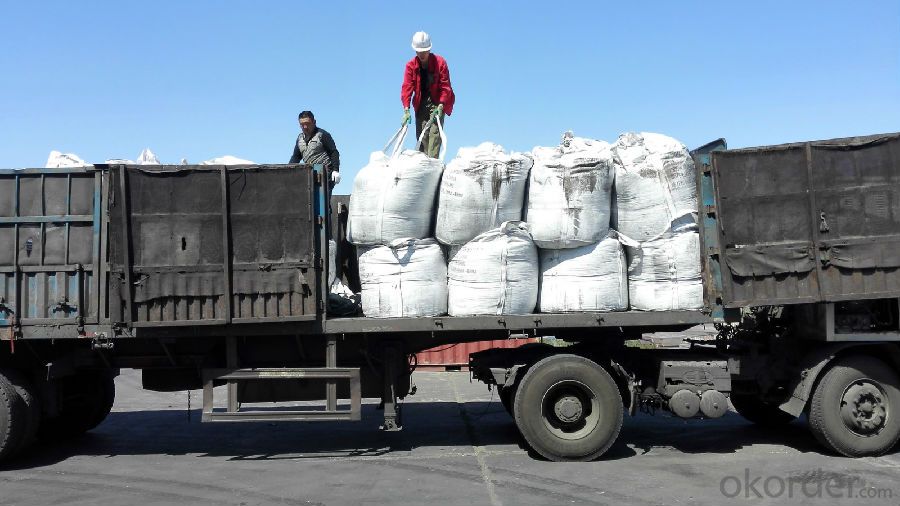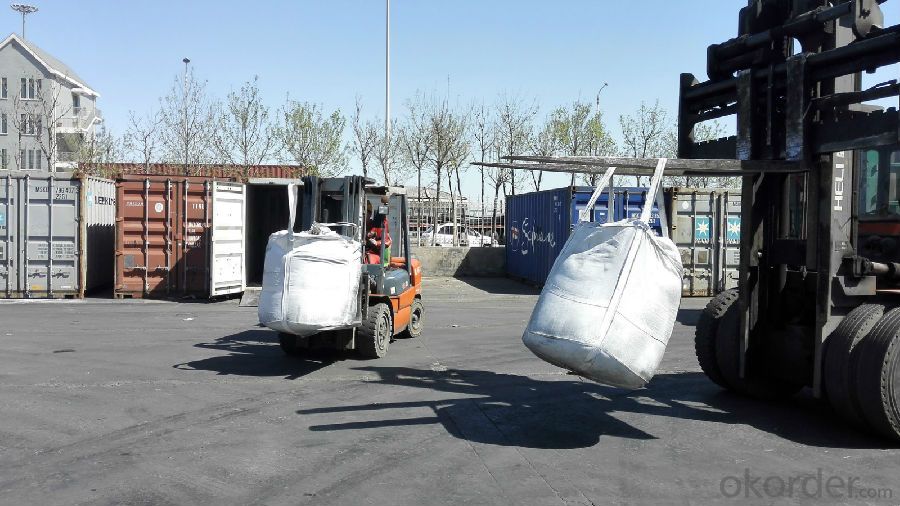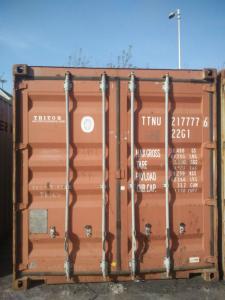S0.5% Recarburizer with fixed caron 95% for steel making
- Loading Port:
- Tianjin
- Payment Terms:
- TT OR LC
- Min Order Qty:
- 20 m.t.
- Supply Capability:
- 1000 m.t./month
OKorder Service Pledge
OKorder Financial Service
You Might Also Like
Item specifice
Introduction:
Calcined anthracite can be called carbon additive, carbon raiser, recarburizer, injection coke, charging coke, gas calcined anthracite.
Best quality Anthracite as raw materials through high temperature calcined at over 2000℃ by the DC electric calciner with results in eliminating the moisture and volatile matter from Anthracite efficiently, improving the density and the electric conductivity and strengthening the mechanical strength and anti-oxidation. It has good characteristics with low ash, low resistivity, low sulphur, high carbon and high density. It is the best material for high quality carbon products. It is used as carbon additive in steel industry or fuel.
Features:
G-High Calcined Anthracite is produced when Anthracite is calcined under the temperature of 1240°C in vertical shaft furnaces. G-High Calcined Anthracite is mainly used in electric steel ovens, water filtering, rust removal in shipbuilding and production of carbon material.
Specifications:
F.C.% | 95MIN | 94MIN | 93MIN | 92MIN | 90MIN | 85MIN | 84MIN |
ASH % | 4MAX | 5MAX | 6 MAX | 6.5MAX | 8.5MAX | 12MAX | 13MAX |
V.M.% | 1 MAX | 1MAX | 1.0MAX | 1.5MAX | 1.5MAX | 3 MAX | 3 MAX |
SULFUR % | 0.3MAX | 0.3MAX | 0.3MAX | 0.35MAX | 0.35MAX | 0.5MAX | 0.5MAX |
MOISTURE % | 0.5MAX | 0.5MAX | 0.5MAX | 0.5MAX | 0.5MAX | 1MAX | 1MAX |
Pictures




FAQ:
Packing:
(1). Waterproof jumbo bags: 800kgs~1100kgs/ bag according to different grain sizes;
(2). Waterproof PP woven bags / Paper bags: 5kg / 7.5kg / 12.5kg / 20kg / 25kg / 30kg / 50kg small bags;
(3). Small bags into jumbo bags: waterproof PP woven bags / paper bags in 800kg ~1100kg jumbo bags.
Payment terms
20% down payment and 80% against copy of B/L.
Workable LC at sight,
- Q:How does carbon affect the growth of plants?
- Carbon is an essential element for the growth and development of plants. It is a key component of organic compounds such as carbohydrates, proteins, and lipids, which are vital for the metabolic processes in plants. Through the process of photosynthesis, plants are able to convert carbon dioxide (CO2) into glucose and other sugars, which serve as a source of energy for growth and various physiological functions. Carbon also plays a crucial role in the formation of plant structures. Cellulose, a complex carbohydrate made up of carbon, hydrogen, and oxygen, provides rigidity and support to plant cell walls, allowing them to maintain their shape and withstand mechanical stress. Additionally, lignin, another carbon-based compound, helps strengthen the stems and roots of plants, enabling them to grow upright and resist bending or breaking. Furthermore, carbon is involved in the regulation of plant hormones and signaling molecules, which control growth, flowering, and other developmental processes. It serves as a building block for the synthesis of numerous plant hormones, including auxins, gibberellins, and cytokinins, which influence cell division, elongation, and differentiation. In summary, carbon is indispensable for the growth of plants as it fuels their energy requirements, provides structural support, and participates in hormonal regulation. Understanding the role of carbon in plant growth is crucial for optimizing agricultural practices, ensuring healthy crop yields, and mitigating the impact of climate change on plant ecosystems.
- Q:What is carbon nanophotonics?
- Carbon nanophotonics is a branch of science and technology that focuses on the study and manipulation of light at the nanoscale using carbon-based materials. It involves the integration of carbon-based nanomaterials, such as carbon nanotubes, graphene, and diamond nanoparticles, with photonics to enable the development of novel optical devices and systems. The unique properties of carbon-based nanomaterials, such as their exceptional electrical conductivity, high mechanical strength, and excellent optical properties, make them ideal candidates for applications in nanophotonics. These materials have the ability to confine and manipulate light at the nanoscale, allowing for the miniaturization of optical components and the realization of enhanced light-matter interactions. Carbon nanophotonics has a wide range of potential applications across various fields. One prominent area is in telecommunications, where carbon nanomaterials can be used to develop high-speed and compact photonic devices for data transmission. Additionally, carbon nanophotonics has the potential to revolutionize the field of sensing by enabling the development of highly sensitive and selective sensors for detecting various molecules and substances. It also holds promise in the field of energy harvesting, where carbon nanomaterials can be utilized to enhance the efficiency of solar cells and other photovoltaic devices. Overall, carbon nanophotonics represents an exciting and rapidly evolving field that combines the unique properties of carbon-based nanomaterials with the principles of photonics to create innovative optical technologies. By harnessing the power of light at the nanoscale, carbon nanophotonics has the potential to revolutionize various industries and pave the way for new advancements in science and technology.
- Q:What are the impacts of carbon emissions on the stability of mountains?
- Carbon emissions can have various impacts on the stability of mountains. One significant effect is the acceleration of glacial melting, leading to increased water runoff and the potential for more frequent and severe landslides. Additionally, carbon dioxide contributes to the acidification of rainwater, which can corrode rocks and weaken the stability of mountain slopes. Climate change, driven by carbon emissions, also leads to alterations in precipitation patterns, temperature, and weather events, increasing the risk of erosion, rockfalls, and avalanches. Overall, carbon emissions have a detrimental influence on the stability of mountains, posing risks to both human populations and ecosystems.
- Q:How does carbon dioxide affect textile production?
- Carbon dioxide can have various impacts on textile production. Firstly, the production of carbon dioxide during the manufacturing process of textiles contributes to the overall greenhouse gas emissions, which exacerbates climate change. This can lead to long-term consequences such as extreme weather events, rising temperatures, and sea-level rise, all of which can disrupt the supply chain and production of textiles. Moreover, carbon dioxide emissions from textile production contribute to air pollution, which can have adverse effects on human health. The release of this greenhouse gas can lead to respiratory problems and other respiratory diseases in workers exposed to high levels of carbon dioxide. Additionally, carbon dioxide is often used as a part of the dyeing and finishing process in textile production. This can have negative consequences for the environment as well. Carbon dioxide can contribute to water pollution when it is released into water bodies during the dyeing process, leading to the contamination of water sources and harming aquatic life. Furthermore, the excessive use of carbon dioxide in textile production can also have economic implications. As carbon dioxide is a byproduct of burning fossil fuels, its production is inherently linked to the consumption of non-renewable resources. The reliance on fossil fuels can make textile production vulnerable to price fluctuations, as the cost of carbon dioxide emissions and energy production can vary significantly. To mitigate the negative impacts of carbon dioxide on textile production, various measures can be taken. These include adopting cleaner production techniques and technologies that reduce carbon dioxide emissions, such as the use of renewable energy sources or implementing carbon capture and storage systems. Additionally, investing in sustainable and environmentally-friendly materials, such as organic cotton or recycled fibers, can also help reduce the carbon footprint of textile production. Overall, the reduction of carbon dioxide emissions in textile production is crucial for the industry to become more sustainable and mitigate its environmental and health impacts.
- Q:How does carbon impact the availability of freshwater resources?
- The availability of freshwater resources is impacted by carbon in several interconnected ways. Climate change is one of the primary means through which carbon affects freshwater availability. The burning of fossil fuels and other human activities result in increased levels of carbon dioxide in the atmosphere, which contributes to global warming. This warming, in turn, leads to changes in precipitation patterns, including alterations in rainfall distribution and intensity. The emission of carbon also leads to warmer temperatures, which can cause higher rates of evaporation and more frequent and severe droughts in specific regions. These droughts reduce the amount of water accessible for freshwater resources like rivers, lakes, and reservoirs. Furthermore, the shifting climate can disrupt natural water cycles, impacting the replenishment of groundwater aquifers, which are essential sources of freshwater. Moreover, the quality of freshwater resources is impacted by carbon. The increased carbon emissions reacting with atmospheric moisture result in acid rain, which acidifies freshwater bodies and renders them unsuitable for many aquatic organisms. This disruption to ecosystems can lead to the loss of species that depend on freshwater resources for their survival. Another manner in which carbon affects freshwater availability is through its influence on land use. The conversion of forests and wetlands into agricultural or urban areas releases carbon stored in vegetation and soil. This not only adds to carbon emissions but also diminishes the ability of natural ecosystems to retain and filter water. Forests, for instance, play a crucial role in maintaining the water cycle by absorbing rainfall and gradually releasing it into streams and groundwater. Deforestation disrupts this process and can result in reduced water availability downstream. In conclusion, carbon emissions have a profound impact on the availability of freshwater resources. Through climate change, carbon alters precipitation patterns, resulting in droughts and decreased water availability. It also affects the quality of freshwater through phenomena like acid rain. Moreover, land-use changes driven by carbon emissions can further diminish freshwater availability by disrupting natural water cycles.
- Q:Appearance, hardness, electrical conductivity, use of carbon 60
- C60 is a molecule composed of 60 carbon atoms in the molecule, it is like football, so also known as footballene (C60. This material is composed of C60 molecules, rather than by the atoms.) C60 is simply made of carbon atoms with stable molecules, it has 60 vertices and 32 sides. The 12 is Pentagon and 20 hexagon. Its molecular weight is about 720.
- Q:How does carbon impact the availability of sustainable development policies?
- Carbon impacts the availability of sustainable development policies by directly contributing to climate change. The excessive emission of carbon dioxide and other greenhouse gases from human activities leads to global warming, which in turn affects natural resources, ecosystems, and communities. To mitigate the negative impacts of carbon, sustainable development policies aim to reduce carbon emissions, promote renewable energy sources, and encourage sustainable practices. By addressing carbon emissions, these policies help create a more sustainable future by preserving resources, minimizing environmental degradation, and fostering social and economic well-being.
- Q:14 is the upper left corner of the mark, please answer a bit more detailed, thank you!
- Enter 14C, select "14", "point font" or "tool" button "superscript"".
- Q:How are carbon compounds classified?
- Carbon compounds are classified based on their structural arrangement, functional groups, and the type of bonds they form with other elements.
- Q:How are carbon markets regulated?
- Carbon markets are regulated through a combination of international, national, and regional frameworks that aim to ensure the integrity and transparency of emissions trading. One of the main international bodies overseeing carbon markets is the United Nations Framework Convention on Climate Change (UNFCCC), which established the Kyoto Protocol and the Paris Agreement. Under the Kyoto Protocol, an international emissions trading system was created, allowing countries to trade emission allowances through the Clean Development Mechanism (CDM) and Joint Implementation (JI) projects. The CDM and JI projects are approved and monitored by the UNFCCC, which ensures that emission reductions are real, measurable, and additional to what would have occurred without the project. The Paris Agreement, which succeeded the Kyoto Protocol, introduced a new market mechanism called the Sustainable Development Mechanism (SDM). The SDM aims to promote sustainable development and help countries achieve their climate goals by enabling emission reductions and removals through projects in developing countries. At the national and regional level, governments and regulatory bodies play a crucial role in the regulation of carbon markets. They establish legal frameworks, set emission reduction targets, and develop domestic emissions trading systems. These systems typically involve the allocation of emission allowances to companies or sectors, monitoring and reporting of emissions, and the trading of allowances on regulated platforms. To ensure the integrity of carbon markets, strict regulations are put in place to prevent fraud, double-counting, and other forms of market manipulation. Independent verification and accreditation bodies are responsible for auditing emissions data and project methodologies to ensure compliance with the established rules and standards. Furthermore, market oversight and enforcement bodies are established to monitor and enforce compliance with the regulations. These bodies have the authority to investigate and penalize any non-compliance, including imposing fines or revoking emission allowances. Overall, the regulation of carbon markets involves a complex network of international agreements, national legislation, and regulatory bodies. The aim is to create a robust and transparent market that incentivizes emission reductions and supports the transition to a low-carbon economy.
1. Manufacturer Overview |
|
|---|---|
| Location | |
| Year Established | |
| Annual Output Value | |
| Main Markets | |
| Company Certifications | |
2. Manufacturer Certificates |
|
|---|---|
| a) Certification Name | |
| Range | |
| Reference | |
| Validity Period | |
3. Manufacturer Capability |
|
|---|---|
| a)Trade Capacity | |
| Nearest Port | |
| Export Percentage | |
| No.of Employees in Trade Department | |
| Language Spoken: | |
| b)Factory Information | |
| Factory Size: | |
| No. of Production Lines | |
| Contract Manufacturing | |
| Product Price Range | |
Send your message to us
S0.5% Recarburizer with fixed caron 95% for steel making
- Loading Port:
- Tianjin
- Payment Terms:
- TT OR LC
- Min Order Qty:
- 20 m.t.
- Supply Capability:
- 1000 m.t./month
OKorder Service Pledge
OKorder Financial Service
Similar products
New products
Hot products



























